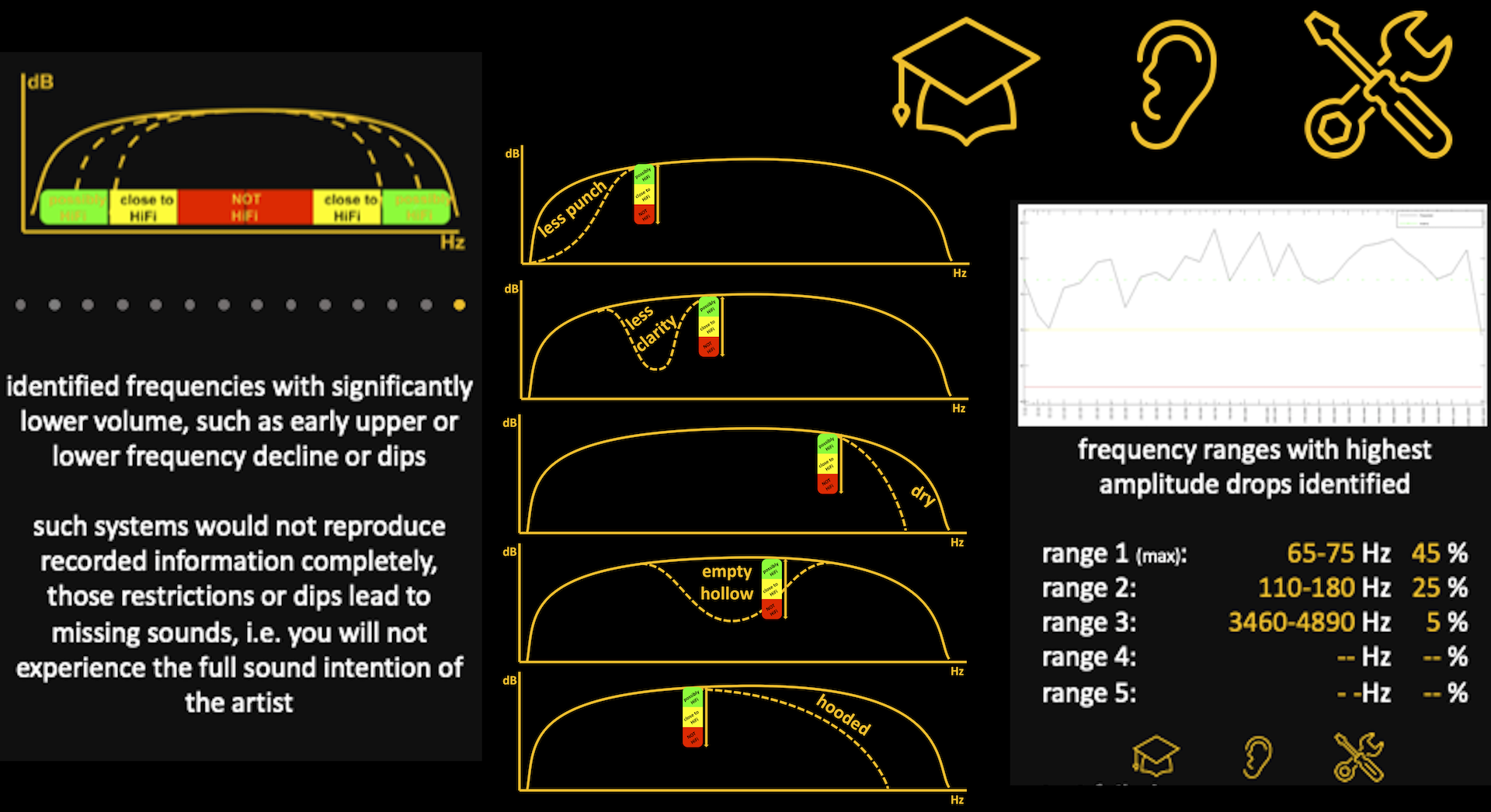
Flaws in audio systems – frequency response amplitude drops
![]() Text to speech – TestHiFi Blog: Flaws in audio systems – frequency response amplitude drops
Text to speech – TestHiFi Blog: Flaws in audio systems – frequency response amplitude drops
Theory explanation 
Frequency response amplitude drops, such as early high or low frequency decline or dips in-between.
It is used to describe the output of an audio system. It represents the amplitude response for each frequency in a range, mostly between 20Hz – 20.000Hz. An audio system should play back an input signal that has a constant amplitude level across the whole frequency range, for every tone in the frequency range, with the same output amplitude level. Any deviation from this output amplitude level would represent a manipulation by the audio system. The flat response is the universal reference for translating the tonal balance of the musician’s original intent to any sound system and between sound systems. No matter if you are listening to a system in your car or to a system in your living room.
The human hearing curve is not flat.
When listening to an instrument being played, the human hearing combines the frequency output of such instrument with the hearing curve to the actual listening experience. An audio system plays back the recording of an instrumental output. Similarly the human hearing combines this output with the hearing curve to about the same listening experience. Ideally the audio system in-between the instrument and the human hearing should not manipulate.
An audio system accelerating or attenuating some tones.
This obviously misrepresents the musician’s original intent. Frequency responses might be not accurately flat on purpose. This allows to receive warmer, bass heavy or brighter sound, depending on ones preferences.
A frequency response of a system is pretty flat if all amplitudes of the frequencies between 20Hz and 20000Hz are in a range of +- 3dB. The difference between the loudest and the most quiet tone could still be up to 6dB in such a flat response. A difference of 10 dB is perceived as a doubling of the loudness of a tone.
A frequency response should be complete.
Independent of individual preferences, no tones should be missing in a frequency range. If there are amplitude differences of 20dB or more, in the range of 70Hz up to 15000Hz (easier to hear than 20Hz-20kHz), those tones would be missing in the listening experience.
This would be a flaw in an audio system.
Depending on the test sound or played music and the environment with its obstructions, like in a big electronics market, it could be difficult to identify such flaws solely by listening.
Impact on listening 
Frequency response amplitude drops result in incomplete reproduction of the music, leading to missing sounds or tones.
Differences in loudness across a key board of a piano
Stroking every key on a piano keyboard, one after the other, with the same strength and receiving some tones less loud than others would be a flaw in the piano that needs to be repaired.
A system with severe frequency response amplitude drops would play some tones less loud than others. This would be a flaw in the audio system, a severe manipulation to the play back, and as such not HiFi.
Missing very deep bass frequencies:

The sound experience is missing deeper punch in bass sounds.
Missing upper bass frequencies:
The sound experience is with less clarity in bass sounds.
Missing highest frequencies:

The sound experience is rather dry.
Missing a wider range of higher frequencies:

The sound experience is hooded.
Missing midrange frequencies:

The listening experience includes voices or instruments that sound a little empty and hollow.
This does not mean at all, not to adjust the tonal balance to our preferences. If we like more basshead, we either choose a respective system or a system including adjustment options like an equalizer.
The ambience influence on the listening
Listening tests or measurements can hardly identify frequencies with their amplitude value, their loudness being below the loudness of the ambience noise. Those tones can hardly be heard, respectively being separated from the ambience noise (no value).
What can I do? When … an audio system 
… buying …
Choose your system in accordance with your listening preference.
The first and foremost important thing is knowing what you want. Systems might be for example basshead, warm, bright or neutral. The frequency response curve will indicate if the weight is more on the lower (basshead), midrange (warm) or higher frequencies (bright).
Choose a system without flaws or tricks.
A system might have flaws in form of drops that negatively influence your listening experience. Position or adjust the system to cover for this flaw. There are several “tricks” available to seemingly make a system sound good. Any severe amplitude drops in the frequency range would be a significant compromise.
Example:
Position a speaker with rather lower bass levels into a corner on the floor, i.e. closely surrounded by stone walls. This will provide stronger reflection of bass frequencies and as such make the bass levels appear higher. When listening to some test music in a store, while in discussion with the seller and obstructed by the store ambience, it might sound appropriate. Back at home, the speaker might be in a totally different environment and position, away from any strong reflecting material. The speaker subjectively still might not sound unbearable bad. A speaker with appropriate bass levels most probably would sound much better.
Making purchase decision on well selected, appropriate and objective criteria allows for better and more sustainable compromise.
… setting up …
Where to place a speaker for the right compromise.
Positioning of your speakers might influence the loudness of some tones. It can make them louder or less loud, i.e. accelerate some tones and attenuate others. Also important is the material, i.e. on which a speaker is positioned, which surrounds a speaker and which is in front the speaker on the ground.
A speaker positioned closely surrounded by walls and the floor, like a stand speaker in a corner and a thick carpet in front, might be more bass heavy. The second stand speaker probably positioned on the other side of the living area, being open to another room and not close to a wall, might be a less bass heavy.
On what to place the speaker for the right compromise.
Positioning of speakers matters, e.g. positioned on the floor, on a shelf or on anything that might cause resonances. Those resonances would be measured as distortions and sound very odd.
Speakers positioned high up from the floor might deliver less trebles. If positioned low they might deliver less trebles and less bass. The speakers output for higher frequencies should be horizontally and vertically geared towards the listening position.
… listening to …
If at your listening position the frequency response is not flat enough, check if the lower amplitude areas at listening position align with the drop areas of your system. Alignment might be regarding amplitude drop size, frequency area, or both. Room acoustic influences may have some impact at the listening position for cases with non-alignment.
